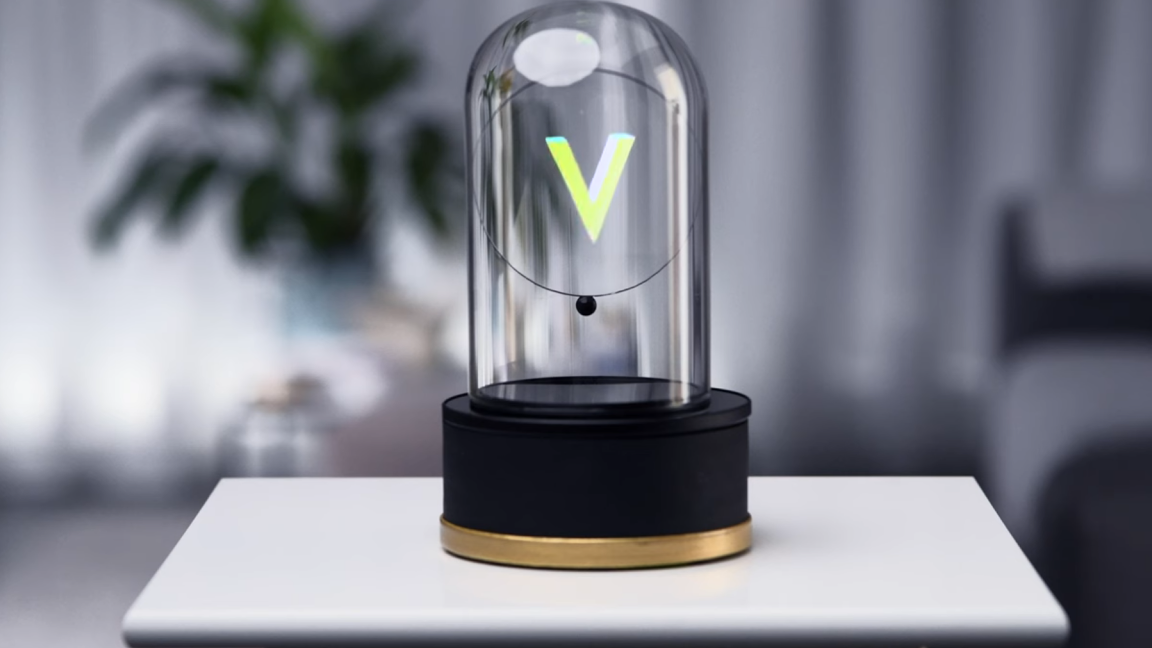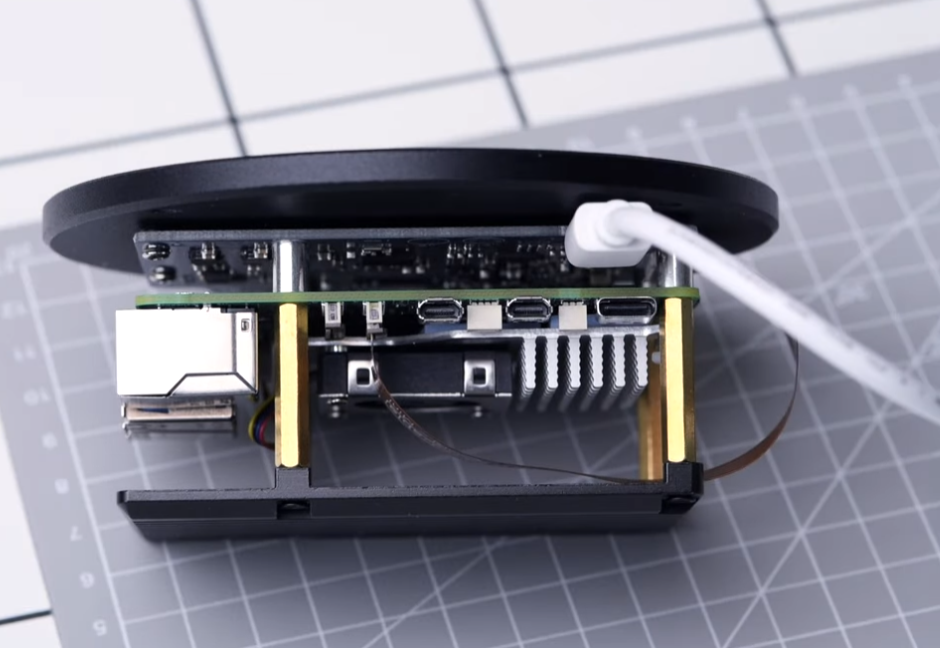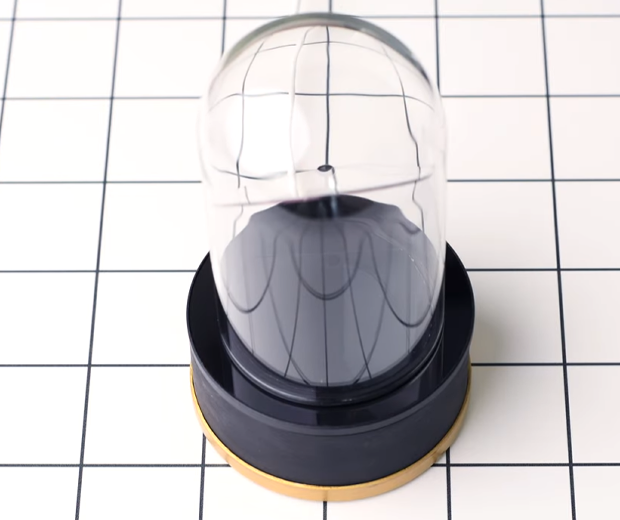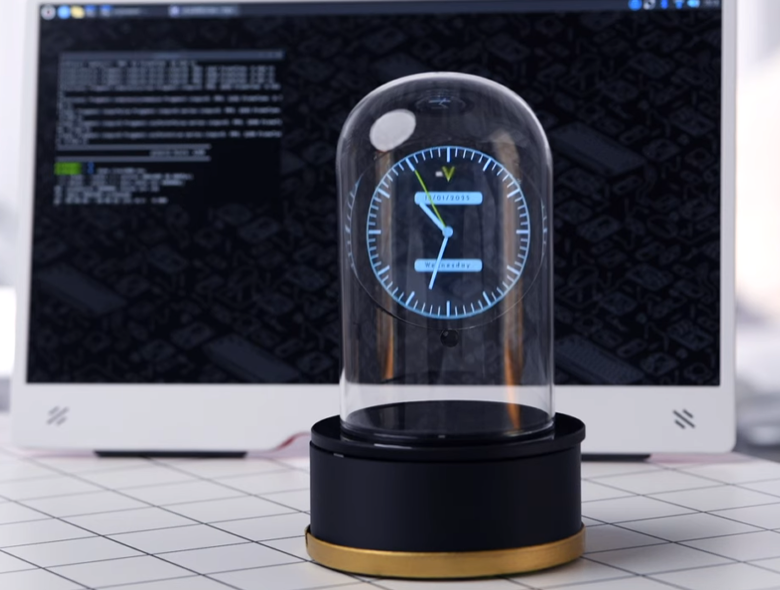This Raspberry Pi transparent display is made using a glass dome

One of the coolest aspects of the Raspberry Pi is its compatibility with a wide range of hardware. For example, makers use all kinds of screens ranging from super wide touch screens to eInk panels. However, VEEB Projects over at YouTube has put together a really cool transparent display using an optical illusion and a glass dome.
This isn't the first Raspberry Pi project we've covered that takes advantage of the Pepper's Ghost effect. One of our favorite examples is this cool ghostly betta fish project that uses a glass sphere to project a fish inside the bowl. Today's project works the same way but works as a general display instead of focusing on a single subject.
Inside the glass dome is a clear reflector that's positioned at a 45-degree angle. The Pi is actually outputting to a small round LCD panel housed in the base of the dome. According to VEEB Projects, it took a bit of algebra to get the distortion just right so the effect looks like an invisible or transparent screen. A privacy shield was also created so you can't easily see the source image from the LCD panel.



VEEB Projects opted to use a 16GB model Raspberry Pi 5 to power the project but you could recreate it with a lighter model like the Raspberry Pi Zero 2. The Pi is connected to a round display, that we mentioned before, which fits easily in the base of the dome. This base was created from scratch by VEEB Projects just for this project and was 3D printed to house all of the hardware inside.
VEEB Projects was kind enough to make the project open source, sharing all of the code you need to recreate the effect and even the 3D models used for the custom base. If you want to get a closer look at the source code, head over to this project page shared to GitHub. That said, it might be tricky find the exact dome you need to fit the design in this project.
If you want to see this Raspberry Pi project in action, head over to the official VEEB Projects YouTube channel. Be sure to follow them for more cool creations as well as any future updates to this one.
Get Tom's Hardware's best news and in-depth reviews, straight to your inbox.

Ash Hill is a contributing writer for Tom's Hardware with a wealth of experience in the hobby electronics, 3D printing and PCs. She manages the Pi projects of the month and much of our daily Raspberry Pi reporting while also finding the best coupons and deals on all tech.
-
bit_user If you want a holographic display, these are the real deal:Reply
https://lookingglassfactory.com/
They use lightfield technology, which involves placing a microlens array atop a conventional LCD panel. The effect is like a real hologram, where the image changes as you move around and the sense of depth can be simultaneously experienced by multiple observers and without any special glasses. -
AnimeMania Question for someone who understands how this illusion works. If you cut the reflector into the shape of a cone and inserted it into the glass dome, would that create an image that could be viewed, no matter where you are, when looking into the dome? I imagine the image might be curved when viewed, but there is probably a way to compensate for that by manipulating the image.Reply -
bit_user Reply
It seems to me like you'd be able to see something from every direction.AnimeMania said:Question for someone who understands how this illusion works. If you cut the reflector into the shape of a cone and inserted it into the glass dome, would that create an image that could be viewed, no matter where you are, when looking into the dome?
I think the correction would be dependent on what direction the viewer is looking at it from. If you just wanted to show some sort of repeating pattern and didn't mind if it curved off at the sides, then I think that would probably be doable.AnimeMania said:I imagine the image might be curved when viewed, but there is probably a way to compensate for that by manipulating the image. -
edzieba Reply
The Looking Glass displays are not lightfield displays, but high density autostereo displays. The image will change with left-right head motion, with enough angles available for the left and right eye to receive the different (and perspective correct) image, but since the panels use cylindrical lenses, moving your head orthogonally to the lenses will have no effect on the displayed image. The trick they use is they slant the cylindrical lenses slightly respective to the panel, so the non-changing axis is just off of vertical so less noticeable and pure vertical headmotions will get a handful of view changes to mask the trick.bit_user said:If you want a holographic display, these are the real deal:
https://lookingglassfactory.com/
They use lightfield technology, which involves placing a microlens array atop a conventional LCD panel. The effect is like a real hologram, where the image changes as you move around and the sense of depth can be simultaneously experienced by multiple observers and without any special glasses.
On top of that: a lightfield display is not just a 2-axis autostereo display, but a display that reproduces ray angles rather than discrete view segments. Unlike an autostereo display where focus is fixed at time of render, a lightfield display would allow a viewer to refocus on different scene depths and receive the correct image. -
edzieba Reply
Pepper's Cone is exactly that.AnimeMania said:Question for someone who understands how this illusion works. If you cut the reflector into the shape of a cone and inserted it into the glass dome, would that create an image that could be viewed, no matter where you are, when looking into the dome? I imagine the image might be curved when viewed, but there is probably a way to compensate for that by manipulating the image.
Like any Pepper's Ghost effect display, the view is orientation dependant, so unless you dynamically update the image with view motion (or display motion) there will only ever be one 'correct' direction where the display shows the desired view. -
bit_user Reply
Source?edzieba said:The trick they use is they slant the cylindrical lenses slightly respective to the panel
Regardless, it's cool tech and what I said about it is remains true - even if the viewer-dependent 3D is primarily limited to one axis.
Isn't the difference just in how you render it? If each pixel encodes a matrix of different viewing angles, then it's up to you whether you send it bundles of rays collected by path tracing vs. different views formed by doing fixed or infinite depth-of-field renders.edzieba said:a lightfield display is not just a 2-axis autostereo display, but a display that reproduces ray angles rather than discrete view segments. Unlike an autostereo display where focus is fixed at time of render, a lightfield display would allow a viewer to refocus on different scene depths and receive the correct image. -
husker Just to be clear: The tech described in this article should in no way be confused with holograms - nor do the authors represent it as such. It's just a display - no more (or less) like a hologram than the monitor you're using to read these comments. The only difference is that they are reflecting the display image off of a transparent surface to make it semi-transparent. Something like this is cheaper and easier, and at least has some very crude hologram effect: Turn Your Smartphone into a 3D HologramReply -
edzieba Reply
Here's a breakdown. They do some funky subpixel rearrangement too, mostly to minimise weird chroma moire issues from having the lens grid and pixel grid misaligned as they would get from a vertical RGB stripe.bit_user said:Source?
Isn't the difference just in how you render it? If each pixel encodes a matrix of different viewing angles, then it's up to you whether you send it bundles of rays collected by path tracing vs. different views formed by doing fixed or infinite depth-of-field renders.
Kiiiiiinda. You could use a very dense autostereo display panel as a lightfield display, but would need to drive it differently. Autostereo displays squidge multiple rendered viewpoints through a fixed plane into a single panel then split those back out again via lens arrays (or aperture masks etc), whereas lightfield displays skip viewpoint intermediaries and figure out what a singular particular virtual ray from the display would be sampling within a scene and what the controbution of that ray to the overall Light Field (hence the name) emitted by the display would be.
